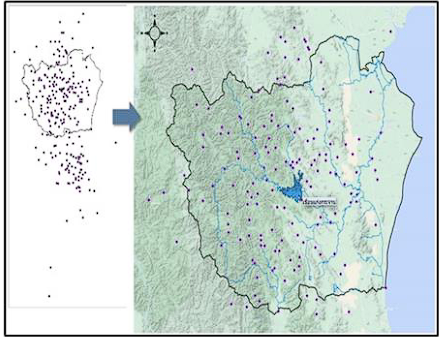Assessment of Royal Rainmaking Performance with Ground-based Rainfall in Phetchaburi River Basin
doi: 10.14456/mijet.2022.8
Keywords:
Phetchaburi River Basin, Royal rainmaking operation, Radar rain, Spatial areal rainfall, Terrestrial rainAbstract
Phetchaburi River Basin is a watershed that connects to the coast. There is a rainy season from May to November. The average rainfall is about 1,000 mm per year, about 200 mm less than the average rainfall in Thailand. Due to the low rain in the area, there is a problem of water shortage for agriculture and consumption. Therefore, the Department of Royal Rainmaking and Agricultural Aviation has carried out Royal Rainmaking operations to increase the amount of rainfall over the basin especially the amount of water flow through the Kaeng Krachan Reservoir. This study assessed the effectiveness of royal rain and terrestrial rain in the Phetchaburi Basin by collecting hourly rainfall data during 09.00-21.00 (12 hrs.) for 14 stations and 4 additional stations studied for installation and radar rain data in the form of a grid obtained from the operation in years 2018-2020. It found that there were 108 days of Royal precipitation during these three years by analyzing the spatial areal using the Invert Distance Weighted technique. The spatial areal rainfall of the two datasets had a correlation coefficient of 0.21, which was a relatively low correlation. Once simulating radar rainfall data, come to the 4 additional stations to find the average daily spatial areal rainfall. The data were then compared with the reference data again. It found that the correlation coefficient increased with correlation coefficient of 0.54. However, it has to wait for the actual measurement results during the Royal Rainmaking Operations Year 2021 from this additional measuring device and use the results obtained to evaluate the achievement of the Royal Rainmaking Operations in the year 2021.
References
[2] X. Wu, S. Niu, D. Jin, and H. Sun, “Influence of natural rainfall variability on the evaluation of artificial precipitation enhancement,” Science China Earth Sciences, vol. 58, no. 6, pp. 906–914, Apr. 2015.
[3] M. Zoljoodi and A. Didevarasl, “Evaluation of cloud seeding project in Yazd Province of Iran using historical regression method (case study: Yazd 1 cloud seeding project, 1999),” Natural Science, vol. 05, no. 09, pp. 1006–1011, 2013.
[4] Q. Luo, Z. Zhou, Y. Meng, Q. Li, and M. Li, “Ground-Based Cloud-Type Recognition Using Manifold Kernel Sparse Coding and Dictionary Learning,” Advances in Meteorology, vol. 2018, pp. 1–9, Oct. 2018.
[5] X. Wu, Ni Yan, and et al, “Advances in the Evaluation of Cloud Seeding: Statistical Evidence for the Enhancement of Precipitation,” Earth and Space Science, vol. 5, pp. 425–439.
[6] G. W. Brier, T. H. Carpenter, and D. B. Kline, “Some Problems in Evaluating Cloud Seeding Effects over Extensive Areas,” Weather Modification Experiments, pp. 209–222, Dec. 1967.
[7] B. A. Silverman, “An evaluation of eleven operational cloud seeding programs in the watersheds of the Sierra Nevada Mountains,” Atmospheric Research, vol. 97, no. 4, pp. 526–539, Sep. 2010.
[8] B. A. Silverman and W. Sukarnjanaset, “Results of the Thailand Warm-Cloud Hygroscopic Particle Seeding Experiment,” Journal of Applied Meteorology, vol. 39, no. 7, pp. 1160-1175, 1999.

Downloads
Published
How to Cite
Issue
Section
License

This work is licensed under a Creative Commons Attribution-NonCommercial-NoDerivatives 4.0 International License.








